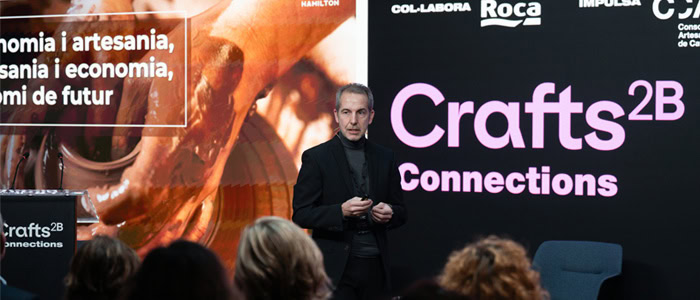Jordi Aymerich gives a presentation at the Craft2B Connections programme organised by the CCAM
Jordi Aymerich, main partner of hamilton, was invited to participate in the «2nd Test of Promotion of Co-creation between the Innovative Company and the High Craftsmanship», an event included in the framework of the Craft2B Connections program, organized by the Consortium of Commerce, Crafts and Fashion (CCAM) with the aim of establishing connections and synergies between the craft sector and innovative companies likely to incorporate crafts into their value proposition.
In his Presentation entitled “Economy and crafts, crafts and economy, a binomial of the future”, Aymerich offered a profound reflection on the interrelation between the economy and crafts, highlighting how both sectors can converge to generate new future opportunities for artisans and the market in general. During his speech, Aymerich recalled a famous quote from David Ogilvy, the renowned publicist: “The consumer does not act as he says, he does not say what he thinks and he does not think what he feels.” This statement underlines the complexity of consumer behavior and the need to understand it through a more detailed and nuanced approach. Against this background, Aymerich presented a clear segmentation of the target audience of the crafts sector, based on previous studies carried out in collaboration with the CCAM.
The importance of consumer segmentation in the craft sector
The segmentation that Aymerich shared is based on data and analysis that accurately defines the different Consumer profiles within the craft market. This segmentation allowed us to identify the purchasing habits and the frequency with which consumers buy artisan products, a crucial factor for artisans when adjusting their commercial strategies. According to the studies presented, a high market penetration is observed in the craft sector, with a relatively low purchase frequency. Only 28.6% of buyers are considered "regular", that is, those who purchase products more than twice a year.
Despite this low purchase frequency, Aymerich noted that this is not necessarily a disadvantage for the sector. He cited a quote from Herbert Bayard Swope that highlights a valuable lesson: "I can't give you the formula for success, but I can give you one for failure: always try to please everyone."This perspective reinforces the idea that craftsmanship must focus on deeply understanding different types of buyers and adapting to their specific needs and desires.
The four segments of the artisan consumer
Within this segmentation, Aymerich distinguished four key groups of consumers, each with its own characteristics and priorities:
- The Singular segment: This group particularly values the originality of handcrafted pieces. Consumers in this profile look for unique products, appreciating the distinction and character of the works.
- The Committed Segment: Consumers in this group are highly committed to the sector and value aspects related to the local economy, diversity and sustainability. They are attracted to products that are not only artisanal, but also support social and environmental causes, favouring responsible and ethical trade.
- The Exclusive segment: Here, the consumer seeks exclusivity and distinction. This group values limited or personalized pieces, and is willing to pay a higher price for products that are not easily found on the market, always looking for what is rare and different.
- The Quality segment: For this group, the quality of the piece is the main priority. They look for products that offer excellent durability and finishes, highlighting the skill and mastery of the craftsman.
Opportunities for artisans
Aymerich's presentation highlighted How artisans can take advantage of these insights. By gaining a deeper understanding of their customers and the factors that influence their purchasing decisions, artisans can more effectively connect with the right audiences, strengthen their market presence, and ultimately improve their competitiveness.
The key is adapt the offers to the specific demands of each of these segments, using accurate data and advanced segmentation to maximize the impact and profitability of the artisan business. In this way, the binomial of “economy and craftsmanship” becomes a powerful formula to create a prosperous and sustainable future, both for artisans and for the market as a whole.
Here you have detailed information about the 2nd meeting of the craft2b connections Program: https://ccam.gencat.cat/ca/arees_actuacio/artesania/serveis-artesania/2a-trobada-crafts2b




